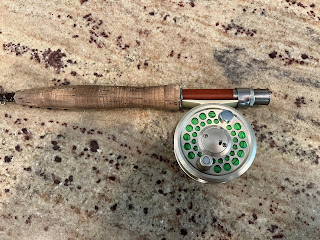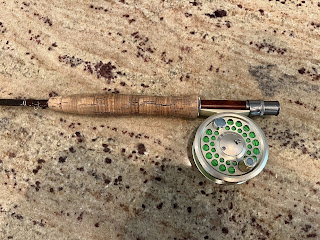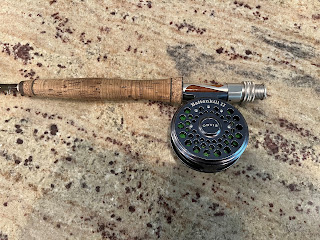When some individuals buy a fly rod they like to pair it with a fly reel that gives them balance with the reel size, its weight, and the weight of the fly rod. When it comes to balancing a fly reel and fly rod it all depends on where you move your forefinger on the cork handle to get the reel and rod to sit in a straight horizontal position. I know a lot of you guys use this method to balance a combo you are purchasing and a lot of fly fishing shops adhere to this method.
I tend to follow my own method which is if you like the feel of the combo then go with it. An example of what I'm talking about is my 5 wt 9 ft. Redington Trout Classic fly rod. This fly rod is the heaviest I use when fishing for the Spotted Bass on Smith Lake. As you can see in the image I have it paired with a Gloomis 3--4 wt. fly reel. The balance, lightness, and appearance I get with this 5 wt. combo suits my needs. The norm recommended by a fly shop would be a 5 wt. or even a 6 wt large arbor fly reel paired with this 5 wt. fly rod. True the balance is there and you have more fly line using a big arbor reel, but does one really need or even use that amount of fly line when landing a larger fish? I feel that large arbor reels have their place in flyfishing but pair this size reel with a 3 or 4 wt. flyrod is a little overboard. I have seen individuals fishing the Sipsey using large arbor reels with an 8 and 8 1/2 ft. 3 wt. They probably view my 9 ft. 3 wt. fly rod paired with my 3 wt. fly reel as lightweight. Pairing fly rods and fly reels in an unconventional fashion is the preference of the fly fishermen.
In this image my 4 wt. 9 ft. Trout Classic is paired with another Gloomis 3--4 wt. fly reel. This flyrod gives me the backbone to land a larger fish if the occasion arises. My 4 wt. is my favorite of all the fly rods I use. It's not heavy and not too light, in other words, it may be the best all-around fly rod for fly fishing. I have no data to back this up but I feel fly fishermen would choose this fly rod as their best all-around fly rod. Both Gloomis fly reels are paired with my 5 and 4 wt. flyrods which are small reels compared to a large arbor reel. Both measure 2 3/4" in dia--1" width and line spool width of 3/4 inch. A 100 ft. of fly line fills both reels without the use of backing. The backing on fly reels is used mainly to fill the spool of the fly reel and not for landing a fish. In fact, if one ever reaches the backing on a fly reel when landing a fish, then they are probably going to lose the fish.
This image shows my 9 ft. 3 wt. Streamflex pair with Battenkill II reel. I like the feel and appearance of this combo. I am interested in how the color of the flyrod matches the reel. I wouldn't fish with a fly rod that has a color other than brown, maroon grey, or green. I guess one can call me old school when it comes to flyrod colors. The reel paired with the Streamflex measures 2 3/4" dia---width of reel is 7/8" and the spool width is 1/2". There is no need for the backing because a 100 ft. of fly line fills the reel spool. The perfect match for this particular flyrod!
This is an older Battenkill I reel that Orvis no longer makes anymore. This is the first small reel I ever bought when I started to fly fish years ago. I have this reel paired with my 7 1/2 ft. Redington Trout Classic 3 wt. It's the perfect combo to fish Walker County Lake and small ponds. I would use it to fish small streams for trout if I had that luxury like some of you guys have in the Northeast. The reel measurements are 2 3/8" width---7/8" reel width and spool width is 1/2". You can see it's been used quite a bit from the dirty cork handle.
What caused me to purchase this combo some years ago was the smaller bluegills and trout I was landing on Walker Lake and the Sipsey. Some years ago the average size trout stocked on the Sipsey was 10". So I thought the 2 and 3 wt. combos would match the catch. It's loads of fun landing smaller fish with a 2 and 3 wt. flyrod. This combo is a 7 ft. trout classic paired with the newer Battenkill I fly reel. Its measurements are 2 5/8" dia.---3/4" reel width and spool width is 3/8". I use 90 ft. of fly line to spool this reel which eliminates backing. The 2 wt and the 3wt. are great combos to start a child fly fishing.
I purchased this flyrod last year on eBay for 90.00 used. It is a 10 ft. 3 wt. Euro Nymphing fly rod that is extremely sensitive using one or two nymphs high-sticking. I've only used this combo a couple of times on the Sipsey last year when generators were not running. After landing a couple of trout on one outing last year, it convinced me Euro nymphing is the way to fish pressure waters like the Sipsey. I wanted to pair this flyrod with a reel that was light to compensate for the hours of drifting nymphs in pocket water and seams I would be fishing. The reel measurements are 2 3/4" dia---reel width is 1" and spool width is 5/8" wide. I spooled the Rio nymphing line on the reel and didn't use a traditional fly line. No casting involved with Euro nymphing just flipping the flies into position and drifting nymphs slow and deep!






When I first started fly fishing, it was recommended that I get a 6wt. I got one with dry and one with intermediate sinking line. From my experience with using a spinning rod, I prefer lighter like a 6'6" medium rod with 2# test. Have landed over 5# trout with it and what a fight. Once I applied that to fly fishing, I settled on 3. A 3wt combo that I'll fish for any size fish and look forward to the fight. After all, "the tug is the drug". If I would lose a fish because it was too light, it would be fish 1, Mark 0.
ReplyDeleteIt's interesting how we all differ when it comes to set ups. Totally based on where you live. I usually fish bigger rivers over small streams. My go to rod is a 6 wt 9 ft 6 inch and I throw on 8 lb test. Haha. Well, I don't lose many fish! I used to fish with 6 lb test, but they would break off and break my heart. So, I'm sticking with the heavier line!!! I do have two lighter weight rods for smaller stuff, but honestly don't use them all that much. Things might change this year though, as I have injured my shoulders and I just might have to go small streams... for now. =)
ReplyDeleteBill this is a post with a great deal of Very useful info. Your pairing of the best possible reel to rod is spot on. Like Mark said there was the time when a 8'6" 6wt was the standard trout rod. But technology went into high gear and look at what we have today.
ReplyDeleteThanks for sharing the interesting combinations that you've tried. Agree that backing on a fly line is rarely needed on most waters and, if it is, that big fish will, in likelihood, be gone!
ReplyDeleteWalt
ReplyDeleteTrue, looking forward to putting some of those combos mentioned in the post to the test soon. Thanks for the comment
Mark
ReplyDeleteWalmart sells a 5/6 wt 9ft. which is much too heavy for a beginner in fly fishing to get the true experience of landing small bluegills or bass. They should sell a 3wt. along with their 5/6 wt. to give customers another option. Thanks for the comment
Alan
ReplyDeleteAnyone starting out fly fishing will never experience the thrill of the sport if they don't have at least 3 different weights fly rods. One needs to experience landing bluegill using a 2/3 wt. to understand what I'm talking about. Thanks for the comment
Emily
ReplyDeleteI agree you need a 6 wt. to land those huge trout where you fish. Individuals who fly fish make a decision every time they go on a fishing trip as to what combos they will use on that particular trip. When I fish the lake I'm always armed with 3 different wt. fly rods so I can experience what it's like to land different size fish. The heavier fly rod is used at daylight to land large spotted bass.
Stay warm out there---thanks for the comment
Hi Bill, I like to go with the 'intuitive' method of pairing rod and reel too. Whatever feels right tends to work. I also own an Orvis Battenkill I reel in silver, and it too has lost the small centre plastic cap on the reverse side like yours has!
ReplyDeleteJustin
ReplyDeleteThe Battenkill fly reels are superd when it comes to lightness and durability. The new models are much improved over the silver edition. The Trout Classic by Redington in the 3 wt 7 ft. length paired with the smallest Battenkill I is excellent to fish for Brook Trout in small streams. Thanks for the comment
As with most things in fly fishing, rod balance is largely subjective. That's why contemporary marketing terms such as "swing weight" tend to really get up my nose.
ReplyDeleteAs someone who's been accumulating tackle for forty years, I don't think the technology has advanced as far as some might belive. The marketing sure is relentless though, (not to mention the horizontal propaganda) and it doesn't help that rod and line manufactures have often drifted pretty far from the AFTM standards.
Agreed----today fly fisherman is bombarded with an endless amount of fly info that is good in some ways but overpowering in others====I like to stick with the basics--thanks for the comment
ReplyDelete